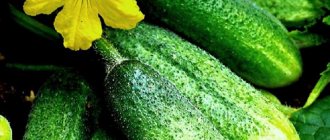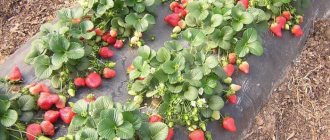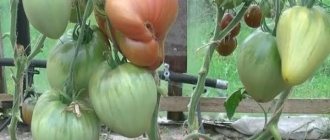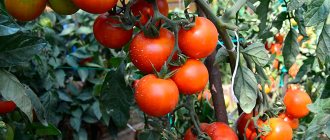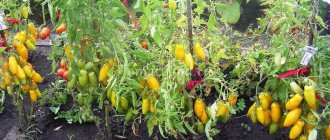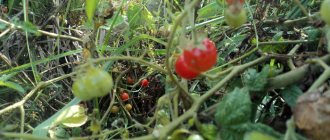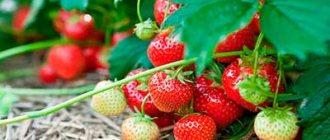Description of Lev Tolstoy tomatoes
Tomato Lev Tolstoy F1 is a young hybrid of the first generation. The plant is of a determinant type; in open ground it reaches a height of 1 m, in protected ground – 1.2 m, then it independently completes its growth.
The top, unlike tomatoes with unlimited growth, ends in a flower raceme. The side shoots also complete their growth. Thanks to this characteristic, the bush grows compact. In the greenhouse, such plants must be placed so that they are not shaded by taller tomatoes.
Tomatoes can be grown without pinching or staking
The leaves of the crop are of medium length, light green in color, moderate foliage. The inflorescences are simple. The ripening period is average, the fruits appear 120 days from the start of cultivation. Hybrid Lev Tolstoy F1 is distinguished by its endurance to weather conditions and diseases. The crop is approved for cultivation in all regions, but is recommended for protected soil.
Important! When choosing seeds, you should take into account that there is a tomato with a similar name - Tolstoy F1, which belongs to the Dutch selection and has other characteristics.
Description of fruits
Large tomatoes have a flat-round shape, medium ribbing, and a bright red color when fully ripe. The weight of one tomato of the Lev Tolstoy F1 variety is 250-300 g; at the beginning of fruiting, tomatoes can be larger and reach 500 g. 6-8 fruits appear in the cluster.
Tomatoes are dense, containing from four to six seed chambers inside.
Lev Tolstoy tomatoes have a good taste and rich aroma, which are preserved during processing. The pulp is sugary, fleshy, juicy, comparable to watermelon, and does not have a sharp sourness. To obtain the declared taste, it is necessary to apply regular fertilizing, especially potash.
General information about the variety
This variety is a hybrid. And hybrids have become very popular in recent years, as they are always distinguished by high performance in one way or another. Gardeners are looking for the best varieties that will save them from a lot of unnecessary work, will not get sick, and the yield will be high. There are many varieties with such indicators, and “Tolstoy” is one of them. It is highly valued by summer residents; the varietal characteristics that we will describe to you below will prove that gardeners’ love is justified.
As for the homeland of this tomato, it was bred here. Breeders wanted to develop a universal tomato that would grow in different conditions of our rich country. At the same time, the variety will produce a harvest both in the greenhouse and in the open ground. We can congratulate our breeders, because they achieved all this in the Tolstoy tomato.
Characteristic
A compact bush with self-limiting growth Lev Tolstoy does not need to be pinched, which is especially suitable for beginner gardeners who have not mastered the complex formation of plants. A garter may be required for the brushes to protect them from breaking and lodging.
Hybrid Lev Tolstoy F1 is unpretentious and can withstand temporary cold spells and temperature fluctuations. But it shows the best productivity in protected ground: in greenhouses or under film covers.
Tomatoes appear on the bush throughout the season. The density of tomatoes allows them to be stored and transported over long distances.
Productivity and fruiting
Tomato Lev Tolstoy F1 has a high yield with a medium-sized bush. In film greenhouses, when placing three plants per 1 sq. m, about 12 kg of fruits are collected from them. The number of tomatoes increases when grown in greenhouses, as well as timely watering and fertilizing.
The plant bears fruit for a long time. Productivity can also be increased if unripe fruits are periodically removed, which promotes the appearance of a new ovary.
Area of application of fruits
The excellent taste and bright aroma of the Lev Tolstoy F1 tomato are especially noticeable in fresh salads, as well as sauces and juice. Tomatoes are suitable for various processing and preparation. Sweet tomatoes are also used for preparing main courses and soups.
The fruits contain many useful substances, so they are recommended for children's diets, as well as people watching their weight.
Resistance to diseases and pests
Tomato Lev Tolstoy F1, thanks to complex breeding work, has acquired resistance to various diseases. This makes it possible not to use chemical fungicides when growing and to obtain a pure product. But to maintain plant immunity, it is necessary to keep the soil clean, ventilate, and avoid excessive watering.
Tolstoy tomatoes on video
Originator of the hybrid: Bejo Zaden (Holland).
You can see other interesting varieties and hybrids of tomatoes with photos, descriptions and reviews in our Tomato Catalog. Enjoy watching.
If you grew Tolstoy F1 tomatoes, please write whether you liked them or not. What was the yield and taste of the fruits like under your climatic conditions? How do you rate the disease resistance of this tomato? Describe the advantages and disadvantages of this tomato in your opinion. If possible, attach to the comment a photo of the entire bush as a whole or individual fruits that you grew. Thank you!
Your reviews of the Tolstoy tomato and additions to the description will help many gardeners evaluate this hybrid more objectively and decide whether it is worth planting or not.
Advantages and disadvantages of the variety
Tomato Lev Tolstoy F1 is a hybrid of Russian selection, medium ripening, created taking into account climatic conditions and is suitable for cultivation in various regions.
pros
- medium-sized compact bush;
- high productivity;
- long fruiting period;
- there is no need for complex shaping and tying of stems;
- beautiful fruits that have a fruity taste, suitable for children's and dietary diets;
- tomatoes can be used for various types of processing;
- the fruits are distinguished by keeping quality and transportability;
- The variety is resistant to typical diseases.
Minuses
- the inability to reproduce the crop with its own seeds;
- it is necessary to maintain soil nutrition throughout the entire growing period.
Advantages and disadvantages
Positive reviews about this variety are explained by the fact that it can be used for planting in any Russian regions. Lev Tolstoy produces high yields, it is unpretentious to growing conditions, its fruits are universal, and the bushes tolerate various temperatures and are practically not afraid of diseases. The variety is persistent and does not require additional shaping.
See also
Description of the Khokhloma tomato and recommendations for growing the variety
Read
The only downside worth noting is that Leo Tolstoy may suffer from late blight. But this is not a big obstacle to getting a good harvest, since the fruits can ripen at home.
Features of cultivation
Tomato Lev Tolstoy F1 is grown in seedlings. Sowing begins in March-April, depending on the location of cultivation. Seedlings can be replanted when the soil warms up to the depth of the root system to +15°C.
The seedling period of the culture lasts from 45 to 50 days
For seedlings, prepare a light and nutritious soil based on peat. Coconut substrate is good for growing tomatoes. It has the necessary loose structure and does not support pathogenic microflora.
Before planting, seeds are disinfected in the preparation “Alirin-B”, which will give the plants even greater resistance to fungal infections. Planting containers are also treated.
Sowing is carried out in moist, leveled soil to a depth of 1 cm. Seeds are germinated at a temperature of +25°C... +27°C for 4-5 days. After the emergence of seedlings, the container is moved to the most illuminated place. Plants need 12-14 hours of light per day with a break at night.
When the seedlings have 2-3 true and well-developed leaves, they are planted in larger containers. Including those plants that were grown in individual containers.
Advice! In case of low soil fertility, several granules of complex fertilizer are added to the container during picking.
Seedlings are watered moderately; containers must contain a drainage hole to drain water. A week before transferring to a permanent place, the plants are hardened off.
In open ground or greenhouses, a single-row or double-row planting scheme is used. The distances between plants are about 0.5 cm, in rows - 0.6-0.7 m. The beds are prepared in advance; it is better to plant green manure on them from the previous season to improve and restore the soil. Before planting, the soil is loosened well, all weeds are removed and leveled.
The hole is pre-watered abundantly, complex fertilizer and 1 tbsp are added. ash. The components are mixed with the soil so that the root system does not come into direct contact with them. The plants are transplanted together with a lump of earth, covered with dry soil and lightly pressed.
Advice! In order for a strong root system to form, watering begins only 10 days after transplantation.
In addition to complex fertilizers, it is effective to use ash, which is scattered in a thick layer between the rows during the period of fruit filling. Only dry ash is used, because when wet it quickly releases useful substances.
Agrotechnics of cultivation and care
Hybrid Tolstoy F1 is excellent for cultivation both in beds and in greenhouses in trellis culture. It is unpretentious, disease-resistant, and demonstrates stable yields even under unfavorable weather conditions. Gardeners in the southern regions can plant this tomato in open ground, but to get an early harvest in the middle zone it is better to use stationary shelters. Regardless of this, growing tall hybrids always begins with obtaining healthy and strong seedlings.
Tolstoy tomato seedlings are planted in a permanent place at an age of at least 60-65 days. Sowing of seeds begins at the end of February and continues in March. The exact timing is determined based on local climatic conditions and the area where the tomatoes will grow. Seedlings for greenhouses begin to be planted earlier than for open ground. Planting work in the garden is carried out approximately from May to early June.
Tolstoy F1 tomato seeds are purchased only in stores. The original planting material has already undergone the necessary preparation for sowing, calibration, dressing, etc., so there is no point in doing it again. If there is no doubt about the freshness of the purchased seeds, they are planted dry, otherwise they are soaked in growth stimulants.
To grow tomato seedlings, use homemade soil or a ready-made universal substrate for vegetables. Individual or shared containers are used as containers. These can be plastic or peat pots, cassettes, homemade boxes, milk cartons, 200-300 ml cups. A prerequisite is also the presence of drainage holes to drain excess liquid in the bottom of the container used.
Tomato seeds are sown to a depth of 1 cm in well-moistened soil. To retain moisture and create a favorable microclimate for the early appearance of sprouts, the containers are covered with glass or film. When planting in common boxes, leave 1.5-3 cm between plants in a row, and 5-7 cm between rows.
Water tomato seedlings generously, but not very often. For irrigation, warm snow or settled tap or well water is used. Each subsequent watering is carried out only after the top layer of soil has dried. Plants from common containers, when they have 2-3 true leaves, are transplanted into a separate container. Tomato seedlings in individual pots are not planted.
During 2 months of cultivation, young tomatoes are fed several times with fertilizers. Optimal for plant growth and development is the use of complex preparations every 10-15 days. Such fertilizing is combined with watering. 7-10 days before transplanting into open ground, tomato seedlings begin to harden.
Tomato seedlings can be planted permanently in a greenhouse or garden bed when the soil temperature is not lower than 15 C˚. Tall Tolstoy F1 hybrids require a large feeding area, so the minimum plants are placed at 4 roots per 1 m2. Before planting, seedlings must be watered. The seedlings are carefully removed from the pots and cups with a lump of earth; after deepening, the soil around the roots is compacted with hands. Afterwards, abundant irrigation of the plantings is carried out.
For better survival of tomato bushes, fertilize with Kornevin, Zircon or similar preparations; work is carried out early in the morning, in the evening or on a cloudy day. Ground seedlings are temporarily covered with film or agrofibre, especially when there is a threat of cold weather and frost.
Features of planting and caring for Tolstoy F1 tomatoes include tying plants to supports and forming a bush. During the growing season, plants can reach a height of 3 m, which means that the use of trellises when growing them is mandatory. Tomato bushes grow into one stem, removing root shoots and all side shoots. The bottom 3 leaves are removed to better ventilate the plants and prevent the spread of diseases. The cutting continues further. After the fruit cluster is poured, 1 leaf is left under it, the rest of the greenery is removed. Large, heavy bunches of tomatoes are tied to trunks or brush holders are used. 2-4 weeks before the end of the growing season, pinch the growing point to allow the fruits set at the top to fully form and ripen on the bush.
The remaining procedures for caring for Tolstoy tomatoes remain standard. Plants need regular watering, loosening the soil after watering, weeding, and fertilizing with organic and mineral compounds. Harvesting is carried out as the fruits ripen. Green tomatoes store well and can be used for ripening and fresh eating in late autumn. The fruits of the Tolstoy F1 hybrid are not left for seeds.
Pest and disease control
Tomato Lev Tolstoy F1 is resistant to a number of diseases, but it is recommended to treat the soil against pathogens for all crops. In this case, two weeks after planting the seedlings, it is recommended to spill the soil around the bushes with a solution of the fungicide “Glyokladin” at the rate of one tablet per bucket of water.
The soil is spilled both around the bushes and between the rows. Also, to protect against diseases, before planting, seeds are soaked in preparations that disinfect them and saturate them with microelements.
Diagnosis: tachycardia, treatment of the disease
Sometimes the disease is completely asymptomatic and is detected only during a special examination. Most often, people are very negligent about their illness, because they may not be bothered by pain. The presence of tachycardia in a person can be indicated not only by a rapid heartbeat. as well as a number of other secondary signs:
- the appearance of unreasonable fear;
- feeling of restlessness and anxiety;
- insomnia (lack of normal, full sleep);
- increased sweating.
Causes of the disease:
- leading a haphazard lifestyle;
- a large amount of mental work;
- nervous overstrain and exhaustion;
- too strong addiction to alcohol;
- lack of walks in the fresh air, work indoors.
Application
Tolstoy tomatoes F1 are universal in use. A variety of salads, side dishes, and preserves are prepared from ripe tomatoes. These tomatoes are also suitable for pickling and pickling; they retain their shape and do not crack. These fruits make a very tasty juice, with virtually no need to add sugar. In addition, Tolstoy tomatoes are suitable for pickling in an unripe state.
Watch the video ! Tomato Tolstoy
Description of fruits
The tomatoes themselves have no less attractive characteristics: they are round, ideally shaped, aligned, bright red in color, without a green spot.
The taste of the fruit is excellent - 4.9 points out of 5, they are dense, juicy, suitable for fresh consumption and for processing, excellent for whole canning.
Tolstoy tomatoes are attractive for commercial cultivation, they can be harvested in bunches, the internodes are short and strong.
The skin is dense, but thin, and cannot be felt when eating. Tomatoes are easily transported and stored – up to one and a half months. They do not crack if exposed to excess moisture.
Another big plus is that tomatoes do not overripe and do not rot on the bush. Keeping quality in the field is amazing, which allows you to harvest in waves. This is very beneficial for farms.
Gardeners often wonder if there are pink and yellow varieties of Tolstoy tomato? No, the hydride is represented only by red tomatoes.



